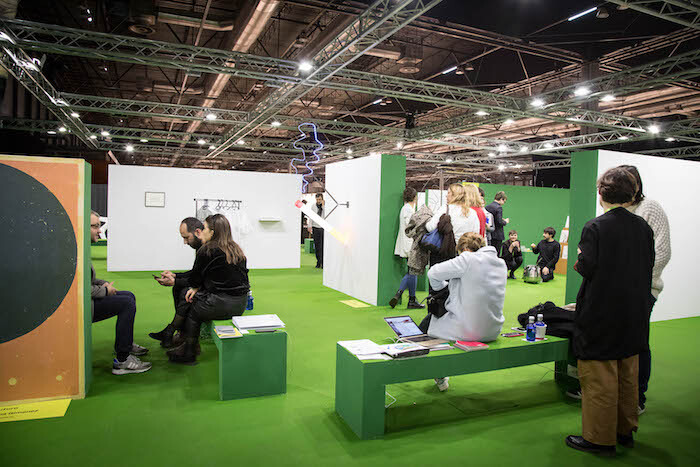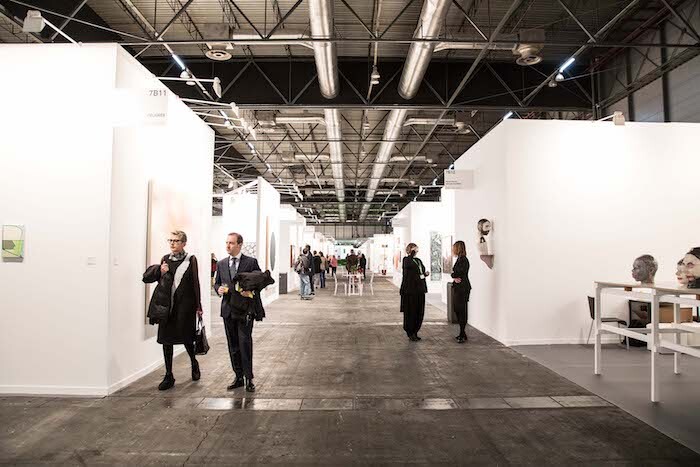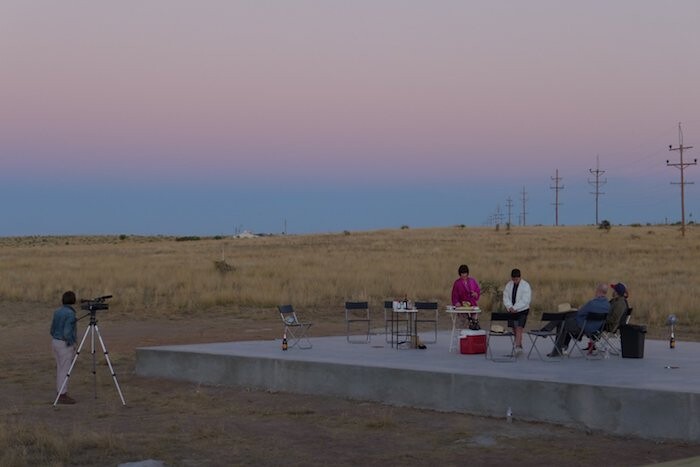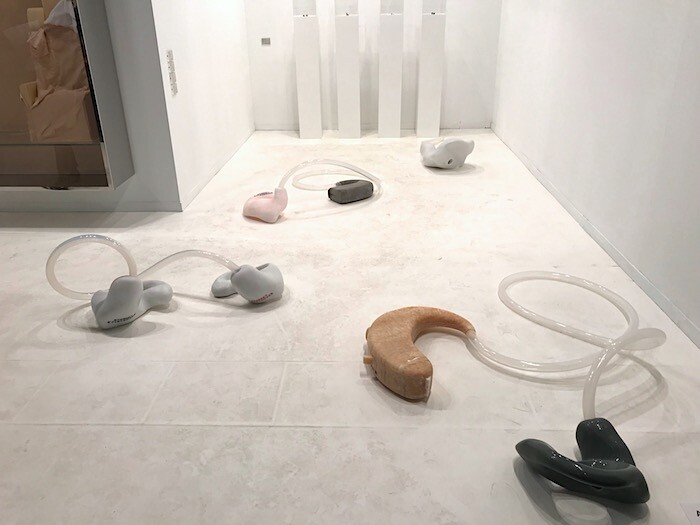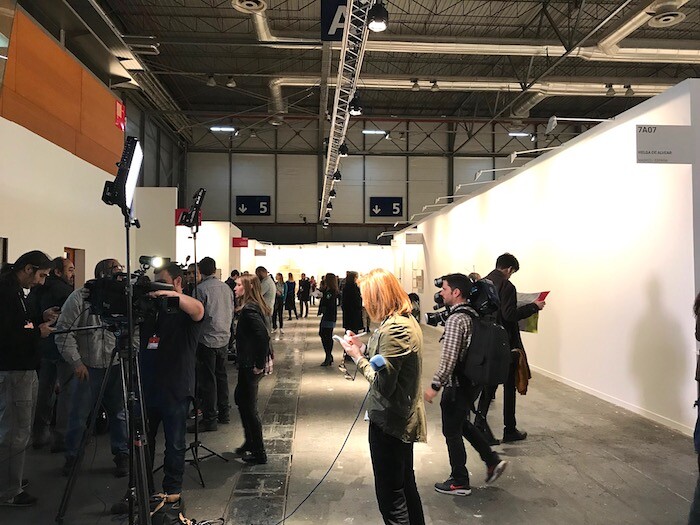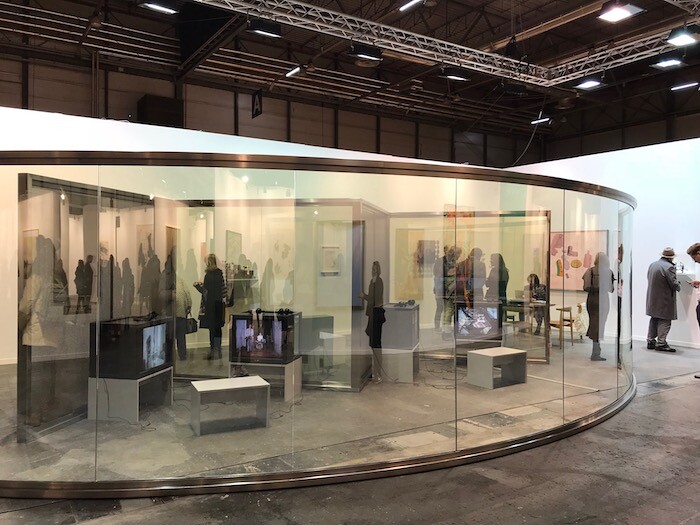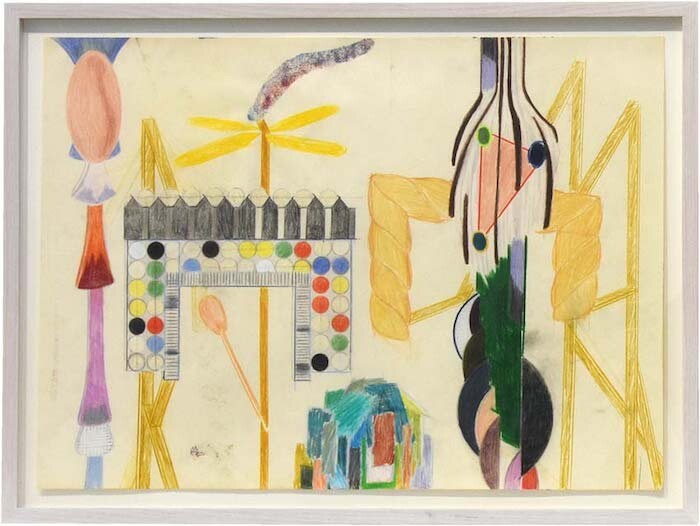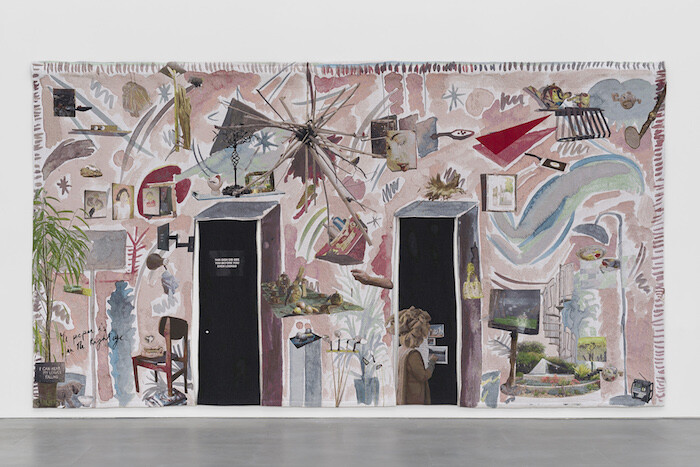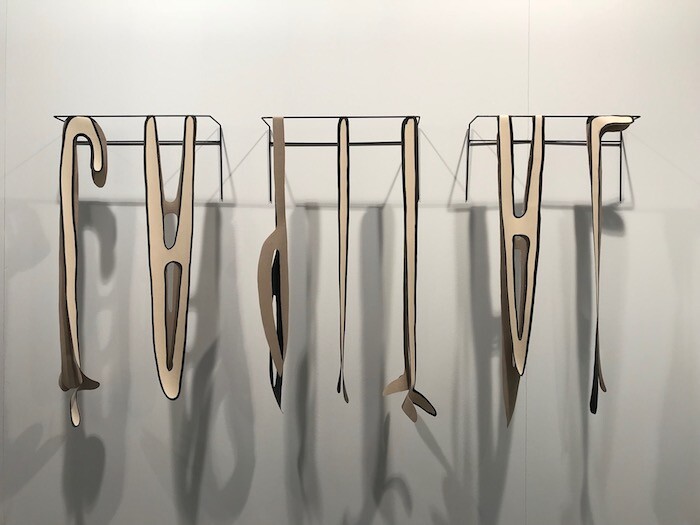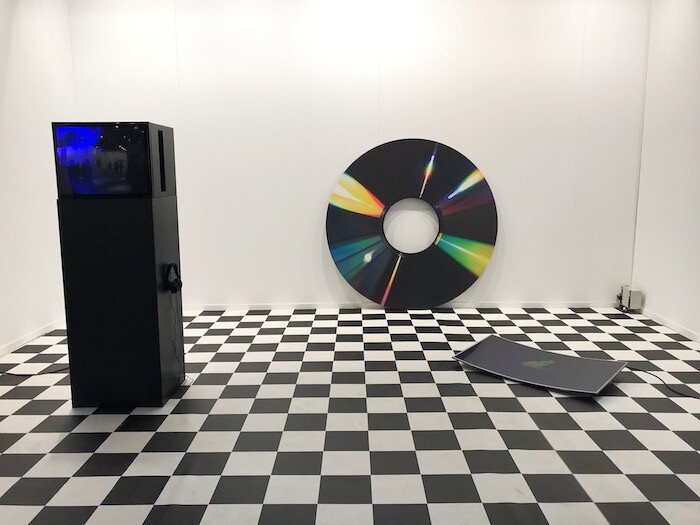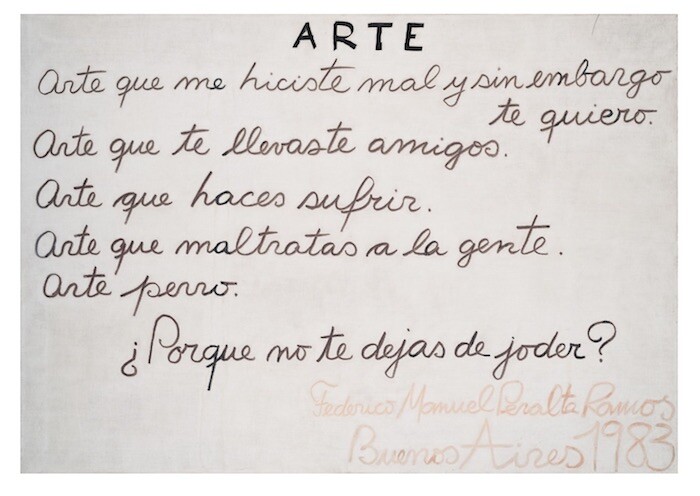This year’s edition of ARCOmadrid embraced a temporal and conceptual gambit: the Future. It was, however, mostly corralled in the eponymous section at the fair, curated by Chus Martínez, Rosa Lleó, and Elise Lammer and featuring works by artists from 20 international galleries, including Nara Roesler, São Paulo; Union Pacific, London; Crèvecoeur, Paris; and A Gentil Carioca, Rio de Janeiro. The works were all installed in a booth-less platform, which made the viewing experience more akin to a group show than a traditional art fair. The elevated area, designed by architect and Manifesta 12 co-curator Andrés Jaque was carpeted with a bright green fabric—theater stage meets mini-golf course—which flattered the playful solo presentations. Eva Fàbregas’s installation for London’s Tenderpixel was generating plenty of attention on preview day. Featuring drawings, sound pieces, and large-scale inflatable sculptures sprawled on the floor and hanging from poles like giant millipedes, Picture Yourself as a Block of Melting Butter (2017) explored the dissolution of the body-object frontier through the lens of somatic experimentation, ASMR techniques, and the commodification of wellness.
Nearby at Berlin’s Chertlüdde, Alvaro Urbano’s sculptures, which borrow architectural elements from Archizoom’s Teatro Impossibile (Impossible Theatre, 1960) stood on the floor awaiting their activation on Friday morning, when they were worn by the artist and paraded across the fair to kick-start the Future talks program, with guests including Trevor Paglen, Nina Power, and Santiago Alba Rico.
But the Future did not only showcase younger artists—like Lili Reynaud-Dewar at Vienna’s Emanuel Layr, Pedro Neves Marques at Naples’s Umberto di Marino, and Teresa Solar Abboud at Barcelona’s Joan Prats. Also from Barcelona, Mayoral presented two rare gender-bending, time-warping drawings created by Salvador Dalí in 1965, a period during which the artist dabbled in fashion design. Nearby, New York’s Bortolami brought a selection of photographs by the brilliant Barbara Kasten, created from 1979 to 2016, and Paris’s GB Agency contributed a poignant presentation of works by the late Slovak artist Július Koller, including a more recent version of one his famous ping-pong tables from the 1970s (Ping-Pong [U.F.O.], 2005), which explored the democratizing aspect of sports as a way to challenge the demise of the democratization process of the Prague Spring after 1968.
Elsewhere, the air was less futuristic than stale retro, bringing echoes of censorships past. As the fair opened, a long wall on the booth of Helga de Alvear, Madrid, located right by entrance, stood empty. Ifema, the public body behind ARCO, asked (and convinced) the renowned gallerist to remove a new work by Santiago Sierra titled Presos políticos en la España contemporánea (Political Prisoners in Contemporary Spain, 2018). The series of 24 black-and-white photographs feature the unnamed, pixelated faces of a string of politicians, activists, and artists currently in Spanish prisons. Crucially, though, the selection also included a very sore subject for the central government: the pro-Catalan Independence politicians and activists imprisoned since late last year and facing charges of sedition and rebellion.
As people flocked to photograph the white wall before it was covered with replacement works by Thomas Ruff, ARCO’s director Carlos Urroz talked to the press to express his disagreement with the decision to take down Sierra’s series, adding that it was the first removal of an artwork in the fair’s 37 years of history. (Later that week Ifema publicly apologized for this request). Meanwhile, according to El País, as the drama unfolded, Presos políticos en la España contemporánea was sold for 80,000 euros to the Catalan TV producer and businessman Tatxo Benet, who’s keen to loan it to museums and galleries so it can reach as many people as possible. As Sierra knows well by now, there’s nothing like a controversy to tenderize the pockets of collectors. After all, there’s nothing that the art market won’t metabolize.
And indeed, as the battle between a fresher, freer future and a rancid, repressive past was playing out (conceptually, at least), across the aisles at the fair it was business as usual. The mood on the floor was dynamic on preview, with sales and inquiries happening quickly from the early hours. In the General section, returning blue-chip galleries like Thaddaeus Ropac and Hauser & Wirth were reporting early sales, their booths packed with people. Berlin’s König Galerie made its ARCO debut with a phenomenal booth showcasing works by Alicja Kwade, Camille Henrot, and Monica Bonvicini, among others. A series of hearing aid sculptures by Amalia Pica, titled “In Praise of Listening” (2017), stood out particularly. Lying on the floor, blown up out of scale, Pica has elevated these small plastic prostheses, which tend to remain hidden in everyday life, into enchanting objects in marble and granite, dignifying their almost miraculous function and organic forms.
Elsewhere, Berlin’s Barbara Thumm staged a fantastic two-person presentation, featuring works by Teresa Burga and the brilliant Georgian artist Anna K.E., who showed a large selection of sculptures, drawings, and performative photographs. Another successful pairing was that of Hélène Delprat and Laure Prouvost at Carlier Gebauer, Berlin, as part of the Dialogues section, curated by María de Corral, Catalina Lozano, and Lorena Martínez de Corral. At the booth, the paintings by Delprat and the tapestry installation and video-sculptures by Prouvost fused into an oneiric continuum in which strange characters, hovering between the real and the fictional, weaved narratives to draw the viewer in.
It’s also worth mentioning the significant presence of Portuguese galleries and artists, surely stimulated by the Lisbon iteration of the fair, launched in 2016. A total of 15 Portuguese galleries participated in this edition of ARCOmadrid, including local staples like Cristina Guerra, Pedro Cera, Quadrado Azul, and Nuno Centeno in the General section. Highlights include exquisite sculptural works by André Romão and Joana Escoval at Vera Cortês, and the acerbic soft sculpture Relaxed Capital (2018) by Pedro Barateiro at Filomena Soares. In the Opening section, the newcomer Galeria Francisco Fino stole the show with a solo presentation by Diogo Evangelista, who presented three recent works—two videos and one print—on a checkered floor, like the abandoned pieces of a Lynchian chess game beguiling new players.
But perhaps the best discovery in a genuinely rewarding edition of the fair came courtesy of the Buenos Aires gallery Del Infinito, which showcased a stunning, uplifting solo presentation by Federico Manuel Peralta Ramos, introducing him to the Spanish and international markets. The late artist, a little-known but highly influential figure in the Argentinian avant-garde, combined Dadaist irreverence with a conceptual stance. His paintings, installations, and performances, created through the 1960s, ’70s, and ’80s, made him a cult figure in the Argentinian art scene. Del Infinito is one of the agents that is now working hard to insert Peralta Ramos into global art history—a worthy effort judging by the artist’s emotive yet hilarious works, combining a personal search for meaning (in art, as in life) with an inchoate drive toward institutional critique. As I looked at his 1983 piece ARTE—a small white canvas with a handwritten message that reads: “Art, you did me wrong but somehow I still love you; art, you took some of my friends; art, you make people suffer; dog’s art; why don’t you stop fucking me up?”—it felt like the perfect kind of work for our present times.

